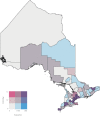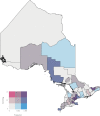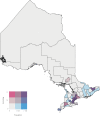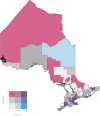Potential for patient-physician language discordance in Ontario
- PMID: 24373325
- PMCID: PMC3909311
- DOI: 10.1186/1472-6963-13-535
Potential for patient-physician language discordance in Ontario
Abstract
Background: Patient-Physician language discordance occurs when the patient and physician lack proficiency in the same language(s). Previous literature suggests language discordant clinical encounters compromise patient quality of care and health outcomes. The objective of this study was to quantify and visualize the linguistic and spatial mismatch between Ontario's population not proficient in English or French but proficient in one of the top five non-official languages and the physicians who are proficient in the same non-official language.
Methods: Using data from the 2006 Canadian census and the 2006 Canadian Medical Directory, we determined the number of non-English/non-French (NENF) speaking individuals and the number of Ontario physicians proficient in the top five non-official languages in each census division (CD) of Ontario. For each non-official language, we produced bi-variate choropleth maps of Ontario, broken down into the 49 CDs, to determine which CDs had the highest risk of language discordant clinical encounters.
Results: According to the 2006 Canadian census, the top five non-official languages spoken by Ontario's NENF population were: Chinese, Italian, Punjabi, Portuguese and Spanish. For each of the top five non-official languages, there were at least 5 census divisions with a NENF population speaking a non-official language without any primary care physicians proficient in that non-official language. The size of NENF populations within these CDs ranged from 10 individuals to 1,470 individuals.
Conclusions: Understanding the linguistic capabilities of Ontario's immigrant population & the linguistic capabilities of Ontario's primary care physicians is essential to ensure equal access and quality of healthcare. As immigration continues to increase, we may find that the linguistic needs of Ontario's immigrant population diverge from the linguistic capabilities of Ontario's primary care physicians. Further research on the language discordance in Ontario is needed in order to reduce the risk of language discordant clinical encounters and the negative health outcomes associated with these encounters.
Figures







References
-
- Kelly PA, Haidet P. Physician overestimation of patient literacy: a potential source of health care disparities. Patient Educ Couns. 2007;13(1):119–122. - PubMed
-
- Lukoschek P, Fazzari M, Marantz P. Patient and physician factors predict patients’ comprehension of health information. Patient Educ Couns. 2003;13(2):201–210. - PubMed
-
- Gardam M, Verma G, Campbell A, Wang J, Khan K. Impact of the patient-provider relationship on the survival of foreign born outpatients with tuberculosis. J Immigr Minor Health. 2009;13(6):437–445. - PubMed
-
- Holden P, Serrano AC. Language barriers in pediatric care. Clin Pediatr. 1989;13(4):193–194. - PubMed
MeSH terms
LinkOut - more resources
Full Text Sources
Other Literature Sources
Medical
Research Materials

